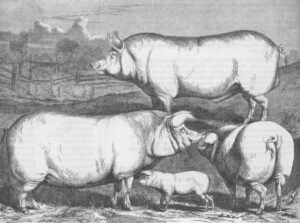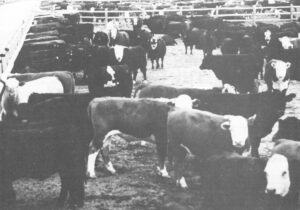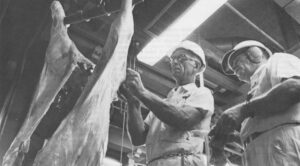I know it’s difficult to extrapolate backwards from one’s dinner plate, where you might have had a pork chop looking up at you, or from a supermarket where you might be visiting the meat counter to decide which steak to buy. To extrapolate back to where all this comes from is what I’ve been trying to do this year, to this incredibly vast world which is like a supply unit that keeps an army in the field and which lies behind the meat that we all eat. It’s a world, as some of you may know, some of you may not, of feedlots that cover hundreds of acres just rolled out with animals shoulder to shoulder, of confinement barns for hogs which are as large as Grand Central Station, no windows, food is brought in mechanically, manure is taken out mechanically. This is an incredible world of technology, and, I might add, a world dependent on drugs and chemicals in order to raise this meat. The meat is relatively inexpensive, actually in many respects, it’s relatively healthy. There are some other respects which do, I think, give one reason for pause.
Four days ago, I visited another livestock facility. This one was in Massachusetts, about 45 minutes from Boston. I arrived there and it was in many ways familiar to what you might see in the Midwest: sort of squat, ugly, square buildings, confinement buildings for the animals. There were feed augers to pump the food into these buildings, manure systems to take the animal waste out. The difference was that at this facility, this feedlot, if you will, they raise and breed mice, rats and guinea pigs. This was the largest breeding lab for these animals in the country and they send a million and a half, two million, of these animals out every year to the FDA, out to all the drug companies who engage in research preliminary to marketing products, to chemical companies. There was about this facility a kind of professional gleam – chrome furniture, little conference rooms, labs with men in white smocks – a kind of reassuring sense of science about it, that we were here engaged in a scientific enterprise which would make one feel certain that this question of testing what we were eating and breathing, etc., was somehow under control.
They had these little chutes. These mice, incidentally, were all born by Caesarean. They were bacteria-free. But, of course, an animal can’t live if it’s bacteria-free because there are certain bacteria, for instance in the intestinal tract, that it must have to live. So they would feed these Caesarean-born, bacteria-pathogen-free animals, a little cocktail full of the right bacteria then put them into these isolation cages where they are pressurized from the inside so that the air would rush out preventing bacteria from coming in. Then they would tumble out of these little chutes, these sort of miniature cattle chutes, into these little mouse boxes with little mouse windows, be loaded onto the trucks and then dispersed across the country.
And the whole sense of this place was that modern science had somehow lived up to the challenge of testing – that we’re in good hands. These little creatures were going to go out, and like litmus paper dipped in chemicals would tell us, they would light up like alarm systems so that we would know ahead of time when something was wrong. The motto of the place, the ads in their publications, they have publications for mouse breeders, one of their mottos is, “Put your money where your mouse is”. Anyway, I left that lab impressed with the industriousness and the scientific acumen of these men in white smocks raising these small creatures.
Two weeks ago on another little adventure, I went out to a slaughter house and I spent some time standing next to a U.S.D.A. inspector. Also in his white smock, standing on the assembly line as the carcasses came down. It reminded me of when I was a child. I remember going to visit a coke factory and all the bottles would parade by in the assembly line and there was one man or woman who would sit there all day watching bottles go by and, if one was nicked or cracked, take it out. And that was the end of that problem. Well, this man’s job is to try – somehow I felt he should have been Superman with x-ray vision – to pick out the carcasses as they went down the line that might have some drug residues in them, might for some reason be contaminated with some chemical compounds, or for one reason or another suggest that they would not live up to the U.S.D.A. standards.
He impressed me as an august, earnest, hard-working fellow, but also somewhat of an antique. He was looking for needle holes, for one thing, to see if farmers had shot these animals up before slaughter time, not observing the proper withdrawal time which all drugs require. But, if he had a suspicion that an animal was contaminated, or if in just the normal course of testing, he would get a computer printout from his headquarters saying, “This month we will test for sulpha, we will test for DES,” or one thing or another, then these tissue samples would be fed into gas chromatographers and mass spectrometers. If he did have a suspicion, he would take a sample. Five days later, seven days later, ten days later, the sample would come back from the lab with the assay on it. Meanwhile, the carcass was miles down the assembly line, probably down here in your local supermarket, or perhaps in your own freezer. And then the laborious process, this antique sort of regulatory process, would grind into action. They would go out to the farm, the ranch, the feedlot and they would tank the herd and do more tests. Again, I had this sense of a world that was trying to come to grips with a problem that it was very ill equipped to do so, with techniques which were out of 50 years ago, that the kinds of technologies in the drugs they were looking for could not be seen so easily, could not be detected.
Let me just tell you the kinds of things which we are developing, which are perhaps not harmful, perhaps harmful, it’s hard to say. And this is what causes concern, at least for me.
There’s a whole new group of pesticides which they fed to the animals. In other words, they don’t spray them, they don’t put them around by some means of mechanical dispensing, they feed it to the animals which makes the manure unappealing to flies to lay their eggs. There are injectible wormers. Rather than shooting it into a cow’s or a pig’s stomach, you just shoot it into the animal’s system itself. All these drugs come with withdrawal times, and I think that they are scientifically correct, if you observe them, this is fine, there are probably no residues, no problems. They have a new drug out, an injectible, which makes a whole herd of cattle cycle into estrous at the same time. So, you don’t have a lot of stragglers, you don’t have a whole herd out there with bulls not knowing when to move, with cows remaining unbred, and inefficiency in the breeding. Take the whole herd in, shoot them up, three days later they all cycle, put them out with the bulls, that’s it.
We’re entering a world which I think is at once quite frightening, but I must also say that as a result of this eight month odyssey that I’ve been on, it’s incredibly exciting. And the strange fact of it all is that what we are seeing, in a very positive sense, is America at its finest. We are seeing this pioneer instinct, this driving force, this dynamism that has really made America great to move on to make things better, bigger, faster, more, cheaper, sleeker, and prettier. And, in a way, these drug companies, these salesmen, these people in the feedlots who are employing all this new technology at a rather reckless pace are at the forefront of something very vital in America. But, my impression, of course, also is that they are at the forefront of something rather unknown. And so, I find myself in trying to write about this, and make sense about this, that on the one hand I’m alarmed, on the other hand, I realize that in fact this is what has brought American agriculture to the incredible state that it is in as the most efficient, most effective, most productive agriculture of any nation in the world.
This poses certain problems from the writing perspective: where are our villains and where are our heroes in this? And where are those wonderful key drugs that the muckraker wants to find, that cause people to grow flippers, or to become cancerous and die? This notion that somehow there are a simple, few, specific things, whether they be radiation, thalidomide, DES, that if we can find them, if we can feed them to these disciplined mice we have in cages, and if they go belly-up, then we know that we will excise these drugs from our regimen and everything will be all right. This urge for the specific I find quite frustrated by what I’ve been seeing: there is no test like this. It is a rare drug, it is a rare agent that is injected into our food which evokes this pleasing finding that really makes the buzzers go off and the lights light up, and we say, stop. All the regulatory machinery roars into action, we get rid of it, and we are in a state of health again.
Rather I find that what is happening – and I think this is true of just about every other area of life that we live in, particularly in food – is this kind of quietly rising tide beneath us of hundreds, thousands of new agents and compounds, techniques, that have a benefit aside. But, the risk side is not clear, dramatic, and exciting. Now the drug companies say, “Where are the corpses? You guys are talking about antibiotic residues and DES, and you’re talking about this, that and the other thing, and not one single person has died from any one of these drugs.” That may be true. But, I suspect that what is really happening here is that try as we will to make the regulator, the meat inspector, the mouse factory be our arms and legs to help guide us, to tell us when we are going astray, it is actually us who will finally come down to be the guinea pig. Because we are dealing with this very complicated world where drugs interact and interact with environmental problems, they interact with air, water, a whole host of other things, which you really cannot effectively test for. You can get some idea, and we certainly shouldn’t abandon these animal studies or the inspectors, but we are operating in this creaky old system while American genius, such as it still is, is churning out new applications and new materials. We’re still looking in a funny way as if when daytime slowly turns to night, as if there were some line, like an international boundary line, where we can say: Now, daytime here – nighttime there; safety here – danger there; benefit here – risk there. And in fact, it’s almost a kindergarten attitude: a very hopeful, naive sense that we can cram this marvelous, booming, dynamic technology into such neat and convincing categories. That we will finally know exactly how to act. That we will be able to isolate out the harmful from the beneficial. I think that this is the frustration we are seeing now politically with all the red tape and these regulatory processes that Reagan is jumping on. We’re entering an era we don’t know how to assay the consequences of what is happening.

And I will just leave you with this poetic thought that meat is for me after eight months really just a metaphor for a host of problems that almost everyone I talk to – I was talking to Nora Ephron about atomic waste – is concerned about. It is really a metaphor for a world, which, as hopeful as we are that someone is in control, finally, really, no one is. And we ourselves will begin to be able to sort out hazard from benefit as we watch what happens to us and our friends. And perhaps even then we won’t know what causes it because of the incredibly complex interaction of all the things which are going on. I’ll leave you with those few words.
©1981 Orville Schell
Following is a transcript of Orville Schell’s remarks on “The U.S. Meat Industry” which were presented at the 1980 APF Competition Lunch.






